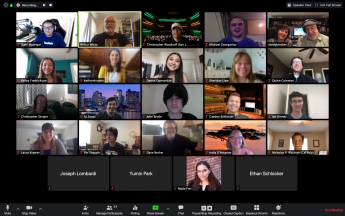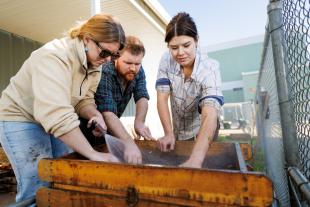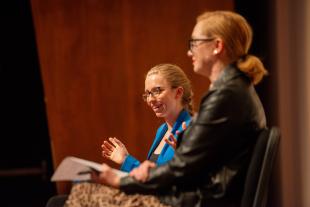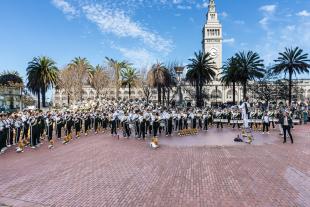Don't Stop the Music: How Jazz Ensembles Kept the Groove Going in a Pandemic

In February 2020, the students in Cal Poly’s jazz ensembles were gearing up to record a CD following a set of concerts around Leap Day.
More than three hundred and sixty-five days and one pandemic later, that CD, titled “another time, another place,” is out and available on streaming services — a testament to their grit and determination to put music out into the world in a time when playing music in a physical group is nearly impossible.
“Normally, we’re all out performing and playing gigs and interacting with people,” said Arthur White, the music department’s director of jazz studies. “We didn’t have that option this year, so we’ve done what we can. This was a way to commit to creating music in this environment.”
The ensembles, which include a big-band style instrumental group and a vocal group, were looking forward to recording when they were sent home for an extended spring break. Then the news broke that they wouldn’t be returning to campus anytime soon.
“Boom, we all got sent home,” said Kelley Fredrickson, a second-year music major and Vocal Jazz Ensemble member. “It was a big shock because we only thought it was going to be a couple of weeks, and then Dr. White told us we all needed to be prepared to record from home.”
On campus, students have access to performance spaces and practice rooms, as well as other group members with whom they can sing and play instruments. But with everyone scattered across the country, unable to rehearse safely in person and dealing with various living situations and technological issues, things got challenging.
“It was really difficult,” said Danna Dumandan, a second-year music major and Vocal Jazz Ensemble member who moved back home when the pandemic began. Dumandan’s living arrangements, including living with eight other family members and sharing a room, made it hard to find quiet time to record a quality take.
“It was always loud in my house,” she said. “It was a really hard schedule to work around because I had to do things around everybody else.”
Ultimately, “I’ve learned a lot about my perseverance as a musician,” Dumandan said. “The fact that I got it done and just didn’t put it down and quit, I’m proud of myself for that and I’m glad I kept going.”
Fredrickson also had to schedule her recordings around family members’ working hours and routines, and found that sometimes noises like airplanes flying overhead or someone nearby mowing a lawn could also affect the recording. But the vocal ensemble pulled together, supporting each other via a group chat and singing their parts to each other to help people practice.
“They were phenomenal the whole quarter and they were just as stressed as I was,” White said. ““This is a really impressive feat that they’ve accomplished.”
The students recorded about two songs a week for a total of eight songs for each ensemble. Typically, when not recording a CD, students learn about four songs in a quarter, Dumandan said. Once all the songs were recorded, White took the recordings and mixed them, trying to make the groups sound as cohesive as possible.
Months passed. Then, over winter break, a package arrived at Dumandan’s house. She eagerly tore it open, revealing the CD she and others had worked so hard on in the early, difficult days of the pandemic.
“I was like, ‘Oh my God,’” she said, adding that she immediately listened to the whole thing. “I can’t believe we did this all by ourselves at our houses.”
Fredrickson also felt a sense of relief and accomplishment.
“When we heard all the songs fully mixed, I felt so accomplished and achieved as a student and with the group, knowing we really completed something that sounds amazing that people can enjoy,” Fredrickson said. “It was just a really great experience and I’m super thankful for it.”
“It really was a Learn by Doing project on every level,” White said. “I’m so proud of these two ensembles not only because they accomplished something they’d never done before, they did it in the middle of a pandemic and they did it without a safety net. I can’t stress enough how significant their work on this record is and how I think everybody who listens to it is going to hear some amazing performances.”




